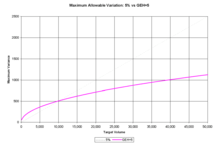GEH statistic

The GEH Statistic is a formula used in traffic engineering, traffic forecasting, and traffic modelling to compare two sets of traffic volumes. The GEH formula gets its name from Geoffrey E. Havers, who invented it in the 1970s while working as a transport planner in London, England. Although its mathematical form is similar to a chi-squared test, is not a true statistical test. Rather, it is an empirical formula that has proven useful for a variety of traffic analysis purposes.
- The formula for the "GEH Statistic" is:
- Where M is the hourly traffic volume from the traffic model (or new count) and C is the real-world hourly traffic count (or the old count)
Using the GEH Statistic avoids some pitfalls that occur when using simple percentages to compare two sets of volumes. This is because the traffic volumes in real-world transportation systems vary over a wide range. For example, the mainline of a freeway/motorway might carry 5000 vehicles per hour, while one of the on-ramps leading to the freeway might carry only 50 vehicles per hour (in that situation it would not be possible to select a single percentage of variation that is acceptable for both volumes). The GEH statistic reduces this problem; because the GEH statistic is non-linear, a single acceptance threshold based on GEH can be used over a fairly wide range of traffic volumes. The use of GEH as an acceptance criterion for travel demand forecasting models is recognised in the UK Highways Agency's Design Manual for Roads and Bridges [1] the Wisconsin microsimulation modeling guidelines,[2] the Transport for London Traffic Modelling Guidelines [3] and other references.
For traffic modelling work in the "baseline" scenario, a GEH of less than 5.0 is considered a good match between the modelled and observed hourly volumes (flows of longer or shorter durations should be converted to hourly equivalents to use these thresholds). According to DMRB, 85% of the volumes in a traffic model should have a GEH less than 5.0. GEHs in the range of 5.0 to 10.0 may warrant investigation. If the GEH is greater than 10.0, there is a high probability that there is a problem with either the travel demand model or the data (this could be something as simple as a data entry error, or as complicated as a serious model calibration problem).
Applications
The GEH formula is useful in situations such as the following:[4][5][6]
- Comparing a set of traffic volumes from manual traffic counts with a set of volumes done at the same locations using automation (e.g. a pneumatic tube traffic counter is used to check the total entering volumes at an intersection to affirm the work done by technicians doing a manual count of the turn volumes).
- Comparing the traffic volumes obtained from this year's traffic counts with a group of counts done at the same locations in a previous year.
- Comparing the traffic volumes obtained from a travel demand forecasting model (for the "base year" scenario) with the real-world traffic volumes.
- Adjusting traffic volume data collected at different times to create a mathematically consistent data set that can be used as input for travel demand forecasting models or traffic simulation models (as discussed in NCHRP 765).
See also
- Microsimulation
- Traffic counter
- Traffic flow
- Traffic engineering (transportation)
- Transportation planning
- Trip generation
External links
- UK Highways Agency's Design Manual for Roads & Bridges (DMRB)
- Wisconsin Microsimulation Modeling Guidelines
- Transport for London Traffic Modelling Guidelines
- National Cooperative Highway Research Program Report 765
References
- ↑ UK Highways Agency, Design Manual for Roads and Bridges, Volume 12, Section 2, http://www.archive2.official-documents.co.uk/document/deps/ha/dmrb/index.htm
- ↑ Wisconsin DOT Microsimulation Guidelines http://www.wisdot.info/microsimulation/index.php?title=Main_Page
- ↑ Transport for London, Traffic Modeling Guidelines Version 3.0, http://content.tfl.gov.uk/traffic-modelling-guidelines.pdf, Retrieved 10-March-2016
- ↑ Shaw, et al (2014), Validation of Origin–Destination Data from Bluetooth Reidentification and Aerial Observation, Transportation Research Record #2430, pp 116–123
- ↑ Van Vliet, D. (2015), SATURN Travel Demand Forecasting Software User's Manual Version 11.3, Section 15.6, http://www.saturnsoftware.co.uk/saturnmanual/pdfs/Section%2015.pdf, Accessed 10-March-2016
- ↑ NCHRP 765: Analytical Travel Forecasting Approaches for Project-Level Planning and Design, http://onlinepubs.trb.org/onlinepubs/nchrp/nchrp_rpt_765.pdf, retrieved 10-March-2016
